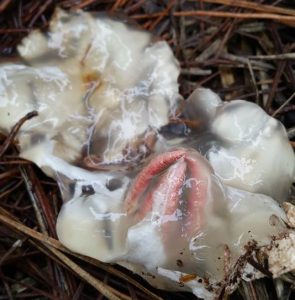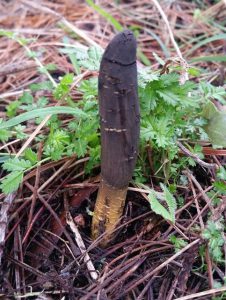Fungi season – it’s better than Christmas!
The long South East winter can be a bit of a struggle sometimes, but I try to look on the bright side: it’s planting time which means plenty of days outdoors getting my hands dirty with workmates and volunteers, and – perhaps my favourite thing about winter – it’s fungi season!
Apart from my early days of mushroom foraging – the first time I identified (the very ubiquitous) saffron milk caps I was so excited I squealed – I think this year’s finds have been the most fascinating. Like any good amateur, I have a couple of fungi books and am part of various fungi-related Facebook groups, so I am sometimes familiar with a mushroom before I come across it in the wild, so to speak. This was the case with a recent fungi find I am about to share here.
Picture this: you’re strolling through the pine forest and come across a monster! Or is it an alien? It certainly looks like one with its red tentacles emerging from a goopy white egg sack. With that image in your mind, scroll down to see how it matches with the Octopus Stinkhorn!
I actually can’t take the credit for finding this beast, as it was in fact one of ForestrySA’s biodiversity corridor program students from Millicent High who first made the discovery. I think he knew he’d found something interesting, but the level of my subsequent enthusiastic delight both surprised and amused the students and staff alike. Once I had explained a little about this mushroom to the students (it’s found all around the world, and its stench attracts spore-distributors) we then discovered we were among a colony of many, many stinkhorns – perhaps up to 40 individual mushrooms!
Luckily for me, I happened to have multiple other planting events nearby over the following week or two, so I got to introduce a number of classes of school students to this special mushroom. I was particularly impressed by how willing some of the Newbery Park students were to investigate the stinkhorn’s smell. Such enthusiastic young scientists!
We discovered, through careful examination of multiple specimens (read: we sniffed a lot of mushies), that this species smells variously like cow poo, sheep poo, fish, or rotting meat – but some mushrooms barely smell at all. The freshly emerged specimens smelt the strongest, and if you accidentally get some of the brown spore goop on your nose or hands you carry that smell with you for a while even after washing it off.
Unlike the Octopus Stinkhorn, my second fascinating fungi find for is not visually striking; in fact, it is quite plain to look at.
What it lacks in looks it makes up for in intrigue though, as this species, Vegetable Caterpillar Cordyceps gunnii, grows out of the heads of wattle moth larvae which in the process become mummified! Jono shared some info about this species in an earlier blog post last year. The mummified caterpillars of Cordyceps mushrooms are also used in Chinese medicine to treat a range of illnesses, and due to over-harvesting have become threatened in some areas.





